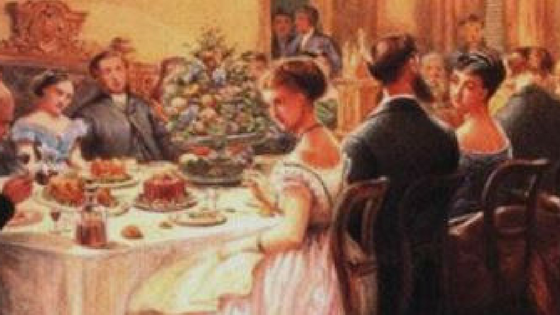
Well-to-do Victorians set an immense holiday table for the Christmas feast. Let’s take a look at some of the ‘’Bills of Fare,’’ or menus, from this festive period, and de-mystify some of the delicacies.
This was a very meat driven holiday meal. Roast goose, or for the very wealthy, roast turkey was only one of the meats served during the meal. There could also be a cold boiled ham, roast duck, and/or venison on the table as well as a roast chicken. The meal could begin with oysters or some kind of seafood soup served with crackers and lemon wedges. There may be a meat or poultry pie along with side dishes like creamed celery, mashed potatoes, mashed turnips, various pickled vegetables and cranberry sauces.

Plum pudding is a historic Christmas dinner staple. Plums, like other stone fruits, are really only available in the summer. So, what is Plum Pudding, or Christmas Pudding as it is also known? The word ‘’plum’’ was used by the Pre-Victorians to mean raisins. The pudding contains dried fruits, eggs, suet and lots of alcohol. It can be made up to a year in advance, and the mellowing time brings is what makes a really good Christmas pudding. In Dickens’ A Christmas Carol, Mrs. Cratchet, ‘’entered: flushed, but smiling proudly: with the pudding, like a speckled cannon-ball, so hard and firm, blazing in half of half-a-quarter of ignited brandy, and delight with Christmas holly stuck into the top.’’ The alcohol, of course, creates the flambé effect that would make a very dramatic ending to a Christmas meal.

Sugar Plums are also associated with Christmas celebration from Tchaikovsky’s Nutcracker Suite Ballet to Clement Moore’s The Night Before Christmas poem. I must tell you now that there are no plums in a Sugar Plum. These are actually candies made by coating a small nut or spice seed like cardamom in layers and layers of sugar syrup similar to the way Jordan Almonds or M&M’s are made. They originated in the 16th century and were extremely difficult to make by hand. This is probably why Sugar Plums were so prized, and the word ‘’plum’’ became synonymous with a wonderful event or item.

Eggnog seems to have a love hate relationship with revelers. You either love it, like it, or won’t get near it. Historically, it’s a beverage of raw eggs, milk, spices (cinnamon and/or nutmeg) and alcohol. The ‘’nog’’ in Eggnog seems to come from the British term‘’noggin,’’ the name of a small wooden cup used for ale. The ‘nog you might buy in the grocery store probably has very few egg products and more gelatin to create the thick, rich texture. The egg and milk mixture can be simmered to make it completely safe for anyone to consume, but loses a little texture. According to Wikipedia, The Rockefeller University Laboratory of Bacterial Parthenogenesis and Immunology conducted a safety test with eggnog and alcohol. The scientists introduced salmonella into their eggnog mixture made with raw eggs. With a 20% alcohol content and three weeks in the fridge, the salmonella was dead and could no longer sicken anyone. As it turns out, aging your ‘nog for up to a year will create a much more mellow drink that is closer to the original.
There are more weird and wonderful Christmas dinner delicacies you can explore from the Victorian Christmas table. What are your traditional holiday treats and dishes?

